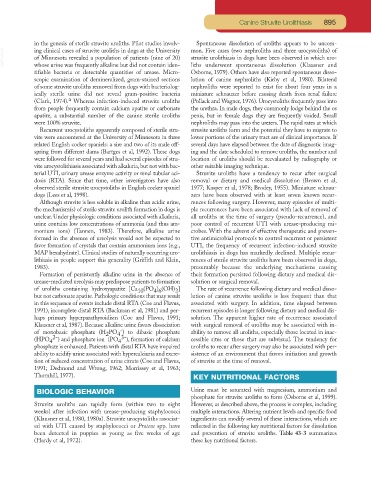Page 864 - Small Animal Clinical Nutrition 5th Edition
P. 864
Canine Struvite Urolithiasis 895
in the genesis of sterile struvite uroliths. Pilot studies involv- Spontaneous dissolution of uroliths appears to be uncom-
VetBooks.ir ing clinical cases of struvite uroliths in dogs at the University mon. Five cases (two nephroliths and three urocystoliths) of
struvite urolithiasis in dogs have been observed in which uro-
of Minnesota revealed a population of patients (nine of 20)
liths underwent spontaneous dissolution (Klausner and
whose urine was frequently alkaline but did not contain iden-
tifiable bacteria or detectable quantities of urease. Micro- Osborne, 1979). Others have also reported spontaneous disso-
scopic examination of demineralized, gram-stained sections lution of canine nephroliths (Kirby et al, 1980). Bilateral
of some struvite uroliths removed from dogs with bacteriolog- nephroliths were reported to exist for about four years in a
ically sterile urine did not reveal gram-positive bacteria miniature schnauzer before causing death from renal failure
a
(Clark, 1974). Whereas infection-induced struvite uroliths (Pollack and Wagner, 1976). Urocystoliths frequently pass into
from people frequently contain calcium apatite or carbonate the urethra. In male dogs, they commonly lodge behind the os
apatite, a substantial number of the canine sterile uroliths penis, but in female dogs they are frequently voided. Small
were 100% struvite. nephroliths may pass into the ureters. The rapid rates at which
Recurrent urocystoliths apparently composed of sterile stru- struvite uroliths form and the potential they have to migrate to
vite were encountered at the University of Minnesota in three lower portions of the urinary tract are of clinical importance. If
related English cocker spaniels: a sire and two of its male off- several days have elapsed between the date of diagnostic imag-
spring from different dams (Bartges et al, 1992). These dogs ing and the date scheduled to remove uroliths, the number and
were followed for several years and had several episodes of stru- location of uroliths should be reevaluated by radiography or
vite urocystolithiasis associated with alkaluria,but not with bac- other suitable imaging technique.
terial UTI, urinary urease enzyme activity or renal tubular aci- Struvite uroliths have a tendency to recur after surgical
dosis (RTA). Since that time, other investigators have also removal or dietary and medical dissolution (Brown et al,
observed sterile struvite urocystoliths in English cocker spaniel 1977; Kasper et al, 1978; Brodey, 1955). Miniature schnau-
dogs (Lees et al, 1998). zers have been observed with at least seven known recur-
Although struvite is less soluble in alkaline than acidic urine, rences following surgery. However, many episodes of multi-
the mechanism(s) of sterile struvite urolith formation in dogs is ple recurrences have been associated with lack of removal of
unclear. Under physiologic conditions associated with alkaluria, all uroliths at the time of surgery (pseudo-recurrence), and
urine contains low concentrations of ammonia (and thus am- poor control of recurrent UTI with urease-producing mi-
monium ions) (Tannen, 1983). Therefore, alkaline urine crobes. With the advent of effective therapeutic and preven-
formed in the absence of ureolysis would not be expected to tive antimicrobial protocols to control recurrent or persistent
favor formation of crystals that contain ammonium ions (e.g., UTI, the frequency of recurrent infection-induced struvite
MAP hexahydrate). Clinical studies of naturally occurring uro- urolithiasis in dogs has markedly declined. Multiple recur-
lithiasis in people support this generality (Griffith and Klein, rences of sterile struvite uroliths have been observed in dogs,
1983). presumably because the underlying mechanisms causing
Formation of persistently alkaline urine in the absence of their formation persisted following dietary and medical dis-
urease-mediated ureolysis may predispose patients to formation solution or surgical removal.
of uroliths containing hydroxyapatite [Ca (PO ) (OH) ] The rate of recurrence following dietary and medical disso-
2
4 6
10
but not carbonate apatite. Pathologic conditions that may result lution of canine struvite uroliths is less frequent than that
in this sequence of events include distal RTA (Coe and Flavus, associated with surgery. In addition, time elapsed between
1991), incomplete distal RTA (Backman et al, 1981) and per- recurrent episodes is longer following dietary and medical dis-
haps primary hyperparathyroidism (Coe and Flavus, 1991; solution. The apparent higher rate of recurrence associated
Klausner et al, 1987). Because alkaline urine favors dissociation with surgical removal of uroliths may be associated with in-
-
of monobasic phosphate (H PO ) to dibasic phosphate ability to remove all uroliths, especially those located in inac-
2
4
(HPO 4 2- ) and phosphate ion (PO 4 3- ), formation of calcium cessible sites or those that are subvisual. The tendency for
phosphate is enhanced. Patients with distal RTA have impaired uroliths to recur after surgery may also be associated with per-
ability to acidify urine associated with hypercalciuria and excre- sistence of an environment that favors initiation and growth
tion of reduced concentration of urine citrate (Coe and Flavus, of struvite at the time of removal.
1991; Dedmond and Wrong, 1962; Morrissey et al, 1963;
Thornhill, 1977). KEY NUTRITIONAL FACTORS
BIOLOGIC BEHAVIOR Urine must be saturated with magnesium, ammonium and
phosphate for struvite uroliths to form (Osborne et al, 1999).
Struvite uroliths can rapidly form (within two to eight However, as described above, the process is complex, including
weeks) after infection with urease-producing staphylococci multiple interactions. Altering nutrient levels and specific food
(Klausner et al, 1980, 1980a). Struvite urocystoliths associat- ingredients can modify several of these interactions, which are
ed with UTI caused by staphylococci or Proteus spp. have reflected in the following key nutritional factors for dissolution
been detected in puppies as young as five weeks of age and prevention of struvite uroliths. Table 43-3 summarizes
(Hardy et al, 1972). these key nutritional factors.

